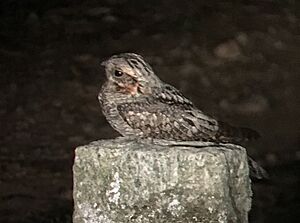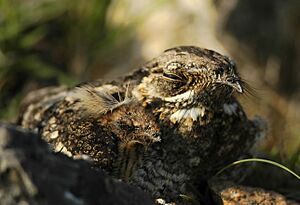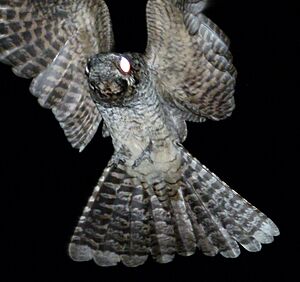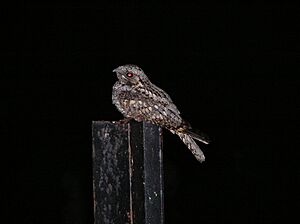Jungle nightjar facts for kids
Quick facts for kids Jungle nightjar |
|
|---|---|
 |
|
| in Anamalai hills, southern India | |
| Conservation status | |
| Scientific classification | |
| Genus: |
Caprimulgus
|
| Species: |
indicus
|
The jungle nightjar (Caprimulgus indicus) is a cool bird found in places like India and Sri Lanka. It's a type of nightjar, which means it's most active when the sun goes down. You'll often spot or hear it near the edges of forests as evening arrives. This bird used to be called the grey nightjar or Indian jungle nightjar. Sometimes, people even thought it was the same as the grey nightjar found in East Asia.
Contents
What Does the Jungle Nightjar Look Like?

The jungle nightjar is about 21 to 24 centimeters (8 to 9.5 inches) long. Birds from Sri Lanka are a bit smaller. This bird is mostly grey with black stripes on its head. It doesn't have a bright patch on its wings; instead, it's a reddish-brown color. Its tail is greyish with thin black stripes that are spaced out.
Telling Males and Females Apart
Male jungle nightjars have a white patch on their throat. This patch is broken in the middle. Females have a reddish-brown throat patch and reddish streaks near their beak.
What Does the Jungle Nightjar Sound Like?
The usual sound it makes is a series of "thacoo" or "chuck" notes. It sounds a bit like a distant engine, repeating about five times every two seconds. Its song is a slow, steady series of "FWik-m" notes. It repeats these for up to 10 seconds! Sometimes, the song ends with quick whistling sounds, like blowing air over an open bottle.
How Scientists Name Birds
Scientists give animals special names to help everyone know exactly which animal they are talking about. This is called their scientific name. The jungle nightjar's scientific name is Caprimulgus indicus. This means "nightjar from India."
Why Names Change
Sometimes, scientists learn new things about birds. This can cause their names to change or for different types to be separated. For example, the jungle nightjar used to include a bird called jotaka from China and Japan. But now, jotaka is its own separate species, called the Grey nightjar. This is because its eggs look different and its calls sound different.
Daily Life and Reproduction
The jungle nightjar becomes active when the sun sets. You can often see it flying over grassy hills or bushy areas. It likes to perch on bare posts or rocks. During the day, it rests in trees, sitting lengthwise along a branch.
Life Cycle and Young Birds
The breeding season in India is from January to June. In Sri Lanka, it's from March to July. The female bird lays two eggs right on the ground. There's no fancy nest, just a bare spot. Both the mother and father bird take turns sitting on the eggs. They do this for about 16 to 17 days until the chicks hatch.




